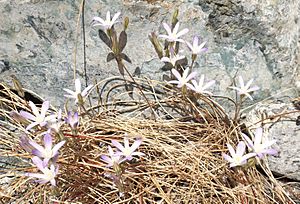Chinese Camp brodiaea facts for kids
Quick facts for kids Chinese Camp brodiaea |
|
|---|---|
 |
|
| Conservation status | |
| Scientific classification |
Brodiaea pallida is a special and rare flowering plant. It is often called the Chinese Camp brodiaea. This plant is part of a group of flowers known as the cluster-lilies.
Contents
Where Does This Plant Live?
The Chinese Camp brodiaea only grows in California, USA. It can be found in two main areas. These areas are located near the border between Tuolumne and Calaveras Counties.
One group of these plants lives near a place called Chinese Camp. Scientists think there are between 600 and 5,000 plants here. This group lives on a piece of land about 65 acres big. In 1998, the government listed this plant as a threatened species. This means it needs protection to survive.
In the year 2000, another group of these plants was found. It was about 24 kilometers (15 miles) away from the first group. This new group might have as many as 10,000 plants! However, building new homes and businesses in these areas is a big problem for the Chinese Camp brodiaea.
What Does It Look Like?
The Chinese Camp brodiaea is a perennial. This means it lives for more than two years. It grows a flower stalk up to about 20 centimeters (8 inches) tall.
The Flowers
The plant has pale purple flowers. Each flower has six parts called tepals. These tepals are about one centimeter long and curve strongly. Inside the flower, there are three white, upright parts. These are called staminodes, and they are not used for making seeds. They are about the same length as the tepals. The parts that do make seeds are found inside these staminodes. The Chinese Camp brodiaea usually blooms in late May and early June.
How Do We Protect This Plant?
This plant likes to grow in special soil. This soil is a mix of dirt from volcanoes and serpentine rock. It grows in wet areas of grasslands, often next to small streams that dry up sometimes.
When the plant was first listed as threatened, it was only known from a very small strip of land. This strip was less than 0.8 kilometers (half a mile) long and only 6 meters (20 feet) wide. Because it was in such a small area, it was at high risk of disappearing completely if something bad happened. For example, some of its habitat was destroyed by building in 1982.
It was listed as "threatened" instead of "endangered" because no more building was planned for that specific area at the time. However, the second group of plants is also on private land. It is near the town of Copperopolis. This area is planned for new houses.
Threats to Its Survival
Even if new buildings are not built exactly where the plants are, nearby development can still harm them. For example, building can change how streams flow. It can also increase water runoff (water flowing over the ground). This can damage the plant's habitat. Building new roads and firebreaks (clear areas to stop fires) can also be a problem.
How It Reproduces
Scientists are still learning about how these plants reproduce. They know the plant can make copies of itself by cloning. This means it can grow new plants from its own parts. It also reproduces sexually by making seeds.


